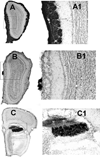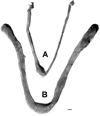Accessory olfactory bulb function is modulated by input from the main olfactory epithelium
- PMID: 20377623
- PMCID: PMC3745274
- DOI: 10.1111/j.1460-9568.2010.07141.x
Accessory olfactory bulb function is modulated by input from the main olfactory epithelium
Abstract
Although it is now established that sensory neurons in both the main olfactory epithelium and the vomeronasal organ may be activated by both general and pheromonal odorants, it remains unclear what initiates sampling by the vomeronasal organ. Anterograde transport of wheat germ agglutinin-horseradish peroxidase was used to determine that adequate intranasal syringing with zinc sulfate interrupted all inputs to the main olfactory bulb but left intact those to the accessory olfactory bulb. Adult male treated mice were frankly anosmic when tested with pheromonal and non-pheromonal odors and failed to engage in aggressive behavior. Treated juvenile females failed to show puberty acceleration subsequent to exposure to bedding from adult males. Activation of the immediate early gene c-Fos and electrovomeronasogram recording confirmed the integrity of the vomeronasal system in zinc sulfate-treated mice. These results support the hypothesis that odor detection by the main olfactory epithelium is required to initiate sampling by the vomeronasal system.
Figures






Similar articles
-
Destruction of the main olfactory epithelium reduces female sexual behavior and olfactory investigation in female mice.Chem Senses. 2006 May;31(4):315-23. doi: 10.1093/chemse/bjj035. Epub 2006 Feb 16. Chem Senses. 2006. PMID: 16484502 Free PMC article.
-
Sexual experience does not compensate for the disruptive effects of zinc sulfate--lesioning of the main olfactory epithelium on sexual behavior in male mice.Chem Senses. 2006 Oct;31(8):753-62. doi: 10.1093/chemse/bjl018. Epub 2006 Aug 10. Chem Senses. 2006. PMID: 16901952
-
Olfactory contribution to Fos expression during mating in inexperienced male hamsters.Chem Senses. 1998 Jun;23(3):257-67. doi: 10.1093/chemse/23.3.257. Chem Senses. 1998. PMID: 9669039
-
The rodent accessory olfactory system.J Comp Physiol A Neuroethol Sens Neural Behav Physiol. 2010 Oct;196(10):767-77. doi: 10.1007/s00359-010-0555-z. Epub 2010 Jul 4. J Comp Physiol A Neuroethol Sens Neural Behav Physiol. 2010. PMID: 20607541 Review.
-
Ominous odors: olfactory control of instinctive fear and aggression in mice.Curr Opin Neurobiol. 2013 Jun;23(3):339-45. doi: 10.1016/j.conb.2013.01.007. Epub 2013 Feb 14. Curr Opin Neurobiol. 2013. PMID: 23415829 Free PMC article. Review.
Cited by
-
Cladistic analysis of olfactory and vomeronasal systems.Front Neuroanat. 2011 Jan 26;5:3. doi: 10.3389/fnana.2011.00003. eCollection 2011. Front Neuroanat. 2011. PMID: 21290004 Free PMC article.
-
Sexual activity increases the number of newborn cells in the accessory olfactory bulb of male rats.Front Neuroanat. 2012 Jul 6;6:25. doi: 10.3389/fnana.2012.00025. eCollection 2012. Front Neuroanat. 2012. PMID: 22783170 Free PMC article.
-
Two predominant MUPs, OBP3 and MUP13, are male pheromones in rats.Front Zool. 2018 Feb 23;15:6. doi: 10.1186/s12983-018-0254-0. eCollection 2018. Front Zool. 2018. PMID: 29483934 Free PMC article.
-
Ephrin-A5 regulates inter-male aggression in mice.Behav Brain Res. 2015 Jun 1;286:300-7. doi: 10.1016/j.bbr.2015.03.001. Epub 2015 Mar 6. Behav Brain Res. 2015. PMID: 25746458 Free PMC article.
-
Differential interactions of sex pheromone and plant odour in the olfactory pathway of a male moth.PLoS One. 2012;7(3):e33159. doi: 10.1371/journal.pone.0033159. Epub 2012 Mar 12. PLoS One. 2012. PMID: 22427979 Free PMC article.
References
-
- Baxi KN, Dorries KM, Eisthen HL. Is the vomeronasal system really specialized for detecting pheromones? Trends Neurosci. 2006;29:1–7. - PubMed
-
- Bean NJ. Modulation of agonistic behavior by the dual olfactory system in male mice. Physiol Behav. 1982;29:433–437. - PubMed
-
- Boehm U. The vomeronasal system of mice: from the nose to the hypothalamus- and back! Semin. Cell Dev. Biol. 2006;17:471–479. - PubMed
-
- Brennan PA, Zufall F. Pheromonal communication in vertebrates. Nature. 2006;444:308–315. - PubMed
Publication types
MeSH terms
Substances
Grants and funding
LinkOut - more resources
Full Text Sources

